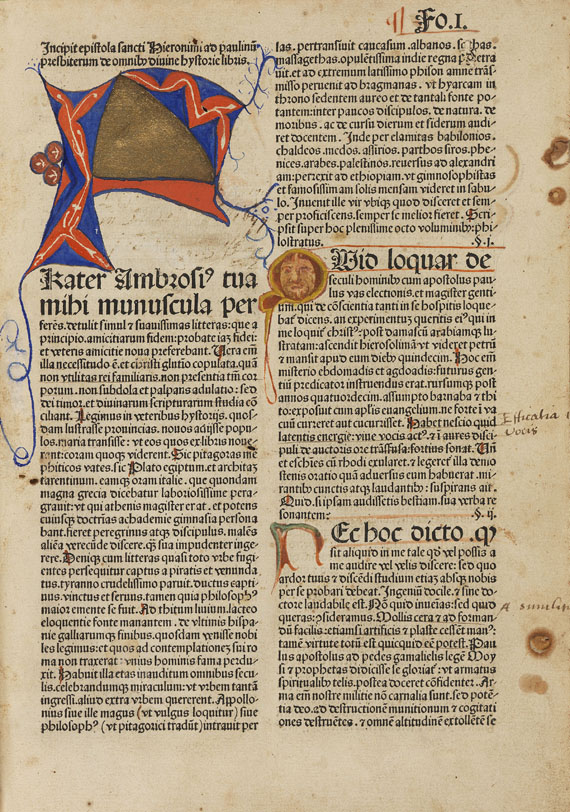BIBLIA LATINA. A fragment of a printed vellum leaf from the 36-line Bible, containing just over a column of printed text. [Bamberg: Printer of the 36-line Bible, not after 1461]
Royal folio, a fragment 393 x 175mm., containing a column from I Corinthians 7:12-25 (bound back-to-front), 36 lines, type 164G, red initial-strokes and with part of a running title in red ink, extracted from a binding with creases and cuts to corners from being folded round a book, and two slits in the text from the insertion of clasps or catchplates, in a modern card cover with green morocco gilt lettering piece, traces of glue on recto, verso soiled
A RARE SURVIVAL of a leaf from the second printed Bible, probably produced in Bamberg, plausibly by Albert Pfister Although post-dating the Gutenberg Bible by a few years, this is a much rarer edition which mostly survives in fragments like this, removed from bindings, with only 14 substantial or complete copies. The complete copies are all on paper, whereas the fragments are on both paper and vellum, and the vellum fragments can be assigned to perhaps six different copies.
The typeface is a recast version of the Gutenberg type (lot 50) in a slightly larger size, resulting in fewer lines per page, and is considered the third state of the D-K type used for this group of the earliest European printed works. Printing must have been completed by 1461 when a copy was dated by its rubricator. The typeface was used by Albert Pfister in Bamberg in 1461-1462, but firm evidence that he was the printer is still to be found. The printing of the bible was commissioned by the Prince-Bishop of Bamberg, Georg von Schaumberg, for whom Pfister worked as a clerk.
A vellum copy was used as binder's waste at the Jesuit College of Munich in the early seventeenth century; other leaves from this copy are now in Munich University Library, the Scheide Library, the Bridwell Library, the Newberry Library, and the Rosenwald Collection at the Library of Congress. The present leaf is sufficiently similar in appearance to indicate the same line of survival.
The traces of a binding stamp can be seen on the left hand edge of this fragment, which may have been used as a liner between the board and the covering.
PROVENANCE[?Munich, Jesuit college]Hartung & Hartung, Munich, Auktion 68, 12-14 May 1992, lot 260The Boehlen collection, Bern, MS 1412
REFERENCESISTC ib00527000; De Ricci (M) 23, this fragment not listed; Eric M. White, "New provenances for four copies of the 36-line Bible", The Book Collector 62 (2013), 403-434
BIBLIA LATINA. A fragment of a printed vellum leaf from the 36-line Bible, containing just over a column of printed text. [Bamberg: Printer of the 36-line Bible, not after 1461]
Royal folio, a fragment 393 x 175mm., containing a column from I Corinthians 7:12-25 (bound back-to-front), 36 lines, type 164G, red initial-strokes and with part of a running title in red ink, extracted from a binding with creases and cuts to corners from being folded round a book, and two slits in the text from the insertion of clasps or catchplates, in a modern card cover with green morocco gilt lettering piece, traces of glue on recto, verso soiled
A RARE SURVIVAL of a leaf from the second printed Bible, probably produced in Bamberg, plausibly by Albert Pfister Although post-dating the Gutenberg Bible by a few years, this is a much rarer edition which mostly survives in fragments like this, removed from bindings, with only 14 substantial or complete copies. The complete copies are all on paper, whereas the fragments are on both paper and vellum, and the vellum fragments can be assigned to perhaps six different copies.
The typeface is a recast version of the Gutenberg type (lot 50) in a slightly larger size, resulting in fewer lines per page, and is considered the third state of the D-K type used for this group of the earliest European printed works. Printing must have been completed by 1461 when a copy was dated by its rubricator. The typeface was used by Albert Pfister in Bamberg in 1461-1462, but firm evidence that he was the printer is still to be found. The printing of the bible was commissioned by the Prince-Bishop of Bamberg, Georg von Schaumberg, for whom Pfister worked as a clerk.
A vellum copy was used as binder's waste at the Jesuit College of Munich in the early seventeenth century; other leaves from this copy are now in Munich University Library, the Scheide Library, the Bridwell Library, the Newberry Library, and the Rosenwald Collection at the Library of Congress. The present leaf is sufficiently similar in appearance to indicate the same line of survival.
The traces of a binding stamp can be seen on the left hand edge of this fragment, which may have been used as a liner between the board and the covering.
PROVENANCE[?Munich, Jesuit college]Hartung & Hartung, Munich, Auktion 68, 12-14 May 1992, lot 260The Boehlen collection, Bern, MS 1412
REFERENCESISTC ib00527000; De Ricci (M) 23, this fragment not listed; Eric M. White, "New provenances for four copies of the 36-line Bible", The Book Collector 62 (2013), 403-434















Testen Sie LotSearch und seine Premium-Features 7 Tage - ohne Kosten!
Lassen Sie sich automatisch über neue Objekte in kommenden Auktionen benachrichtigen.
Suchauftrag anlegen